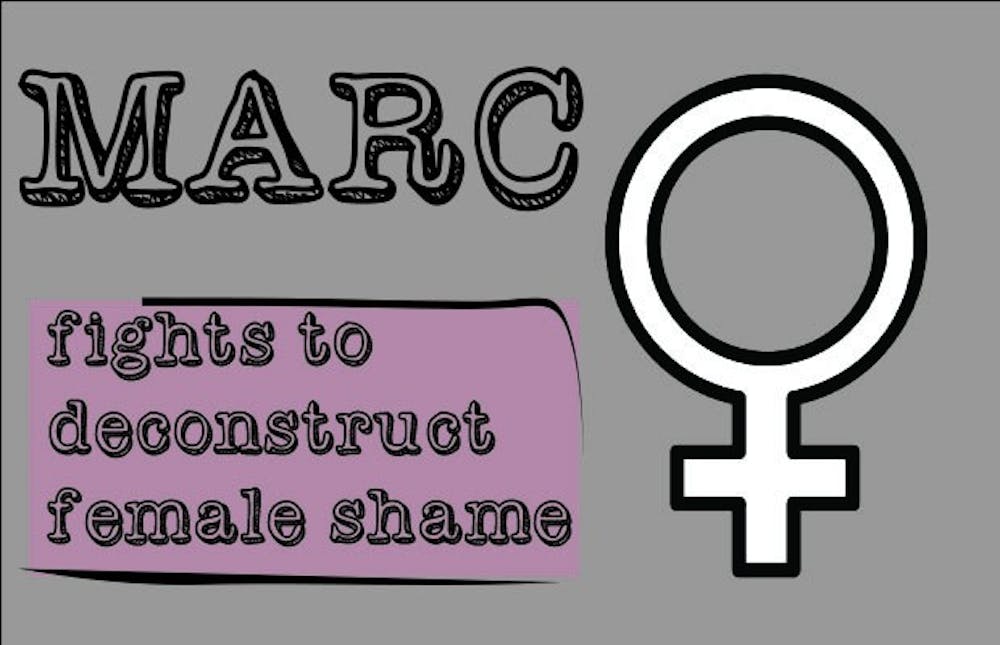 MARC fights to deconstruct female shame. Graphic by Luu Nguyen.
MARC fights to deconstruct female shame. Graphic by Luu Nguyen.Aunt Flow. The end of a sentence. The crimson wave. Shark week.
These coded phrases bury the existence of a woman's monthly visitor.
Take a stroll around campus and consider the people that pass. Stooped beneath the facade of many women is a female-in-hiding. Reduced to defining herself based on societal expectations, women often find themselves obscuring their natural features.
Dr. Breanne Fahs, professor of Women and Gender Studies, facilitates and encourages students to confront the stigma surrounding women and their bodies, specifically female menstruation.
"Menstrual activism is designed to fight back against the shame, secrecy and silence that our culture has surrounding menstruation," Fahs defines.
Under Fahs' mentorship, the Menstrual Activist Research Collective (MARC) was born. Psychology alumna Stephanie Robinson-Cestero worked in conjunction with ASU graduate Jax Gonzalez to found MARC.
Robinson-Cestero and Gonzalez created the collective through an activism project in their Women's Studies class. The project instructed students to design and implement an intervention based on the topic menstruation. The two students realized that menstruation was not obvious or visible.
"Based on community feedback, campus police presence, and our own research, co-founder Jax Gonzalez and I realized that menstruation was much more invisible and taboo than we had previously thought," Robinson-Cestero said in an email interview. The pair created the collective to create workshops and connections with the community. Their goal is to spread their research and to increase awareness of menstruation.
Fahs explains that menstrual activism has multiple goals. The first of these is to perform research and examine how girls and boys are taught about the reproductive system and the menstrual cycle in the classroom. Sometimes, this bodily process is taken out of school curriculums completely.
Secondly, menstrual activists strive to improve the female perspective on the menstrual cycle. According to MARC, the menstrual cycle has the potential to connect women more closely to their bodies.
In addition to instilling body positive messages in women, MARC and other menstrual activism groups advocate for the use of eco-friendly and reusable menstrual products. Divacup and Lunapads are examples of these products, which are not as widely distributed or advertised to women.
These groups also advocate the inclusion of transgender men in conversations about menstruation, as well as providing education to global communities about how to make their own menstrual products. In many countries, women and girls are barred from school when they menstruate.
The collective partners with alternative menstrual product retailers and presents their research at national conferences. In addition to having hundreds upon hundreds of followers, MARC sells activist merchandise through Etsy. Supporters are able to purchase stickers, buttons and t-shirts.
It's not surprising that movements such as MARC are mostly comprised of women. ASU alumnus Michael Karger noticed that very few men were active in this movement. He is a member of the Feminist Research on Gender and Sexuality (FROGS) collective, also headed by Professor Fahs. He acknowledges that few men actively participate in the movement because of the stigma that surrounds menstruation. However, he says he has high hopes for the future.
"As men begin to better understand their role in social conceptions of menstruation, I believe more will join the movement," Karger says.
Female menstruation suffers from societal taboo. Criticism can be found across the internet, but MARC is not the only organization to face backlash from various groups. But these critics fail to intimidate organizations like MARC.
"There is a movement against menstrual activism, and we have felt it minimally within our activism and our work, and for that we feel fortunate to proceed with what we feel is an extremely important topic that is in much need of being made more public," Robinson-Cestero says.
Fahs agrees that criticism is common regarding women's bodies.
"It is common to hear various kinds of trivialization and mockery around activism about women's bodies," Fahs says. "That just shows how much work we still have to do to help women feel empowered and connected to their bodies in a culture that devalues women's experiences."
Karger welcomes the criticism and conflicting analysis of concepts relating to menstruation. He says that the most important thing about criticism is to improve understanding through reason and empathy.
"The movement is simply too imminently important to suffer marginalization from those wishing to break it down," Karger states.
The professor believes that participation in public dialogue about women's bodies can benefit society and ASU students. She cites the fact that women and girls face shame and negativity about their bodies, whether it regards menstruation or body size.
"At its core, menstruation is a signal of physical health and a connection that exists between women," Fahs says.
The professor encourages students to become part of the movement by examining their habits during their menstrual cycle, and improving them. "I would strongly encourage ASU women to try the Divacup or Lunapads - most women who do say they can never go back to disposables and they feel far more positively about their periods as a result," she says.
Fahs says she has high hopes for the menstrual activist movement, especially as it garners much more attention and academic study. The Society for Menstrual Cycle Research, a nonprofit research organization, holds a conference each year that joins the world's menstrual activists.
"There is so much good work surrounding menstrual activism," Fahs says. "There will be more education about menstruation in the classroom, more knowledge of the dangers of mainstream menstrual products and legislation regulating the products."
MARC aims to deconstruct the humiliation and stigma that surrounds menstruation by opening lines of positive communication and exposing menstruation to the mainstream media. The hope of its supporters and members is that this work will continue.
"In the future, we will continue to see the movement expand in scope as a permanent, influential presence precisely because menstrual activism and research exists on the cutting edge of academic, activist and social circles," Karger states.
MARC and others anticipate the day that the stigma surrounding female bodies will disappear. As this movement expands, the hope is that women, and even men, walking around campus will feel comfortable in their skin, hidden no more.
Reach the writer at arabusa@asu.edu or on Twitter @marie_eo.




